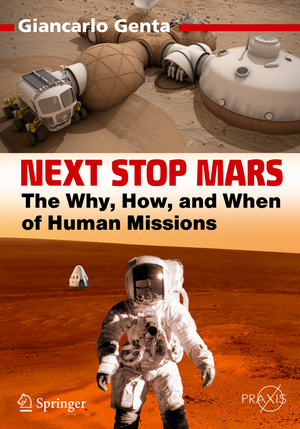Next Stop Mars: The Why, How, and When of Human Missions: Springer Praxis Books
Autor Giancarlo Gentaen Limba Engleză Paperback – 6 ian 2017
As the reality of a manned Mars voyage becomes more concrete, the details are still largely up in the air. This book presents an overview of proposed approaches past, present, and future, both from NASA and, increasingly, from other space agencies and private companies. It clearly displays the challenges and the ingenious solutions involved in reaching Mars with human explorers.
Din seria Springer Praxis Books
-
 Preț: 294.46 lei
Preț: 294.46 lei -
 Preț: 223.45 lei
Preț: 223.45 lei -
 Preț: 193.12 lei
Preț: 193.12 lei -
 Preț: 167.85 lei
Preț: 167.85 lei -
 Preț: 288.98 lei
Preț: 288.98 lei -
 Preț: 323.74 lei
Preț: 323.74 lei -
 Preț: 401.38 lei
Preț: 401.38 lei -
 Preț: 264.12 lei
Preț: 264.12 lei - 8%
 Preț: 513.00 lei
Preț: 513.00 lei -
 Preț: 190.01 lei
Preț: 190.01 lei -
 Preț: 218.16 lei
Preț: 218.16 lei -
 Preț: 312.06 lei
Preț: 312.06 lei - 17%
 Preț: 414.05 lei
Preț: 414.05 lei -
 Preț: 216.41 lei
Preț: 216.41 lei -
 Preț: 262.27 lei
Preț: 262.27 lei -
 Preț: 264.35 lei
Preț: 264.35 lei -
 Preț: 167.63 lei
Preț: 167.63 lei -
 Preț: 284.81 lei
Preț: 284.81 lei -
 Preț: 259.08 lei
Preț: 259.08 lei -
 Preț: 305.47 lei
Preț: 305.47 lei -
 Preț: 244.14 lei
Preț: 244.14 lei -
 Preț: 227.85 lei
Preț: 227.85 lei -
 Preț: 285.25 lei
Preț: 285.25 lei -
 Preț: 295.56 lei
Preț: 295.56 lei -
 Preț: 357.17 lei
Preț: 357.17 lei -
 Preț: 275.79 lei
Preț: 275.79 lei -
 Preț: 257.08 lei
Preț: 257.08 lei -
 Preț: 349.71 lei
Preț: 349.71 lei -
 Preț: 272.45 lei
Preț: 272.45 lei -
 Preț: 270.27 lei
Preț: 270.27 lei - 8%
 Preț: 456.51 lei
Preț: 456.51 lei -
 Preț: 352.34 lei
Preț: 352.34 lei - 8%
 Preț: 394.80 lei
Preț: 394.80 lei -
 Preț: 320.65 lei
Preț: 320.65 lei -
 Preț: 325.29 lei
Preț: 325.29 lei -
 Preț: 253.11 lei
Preț: 253.11 lei -
 Preț: 192.86 lei
Preț: 192.86 lei -
 Preț: 313.40 lei
Preț: 313.40 lei -
 Preț: 150.51 lei
Preț: 150.51 lei -
 Preț: 233.34 lei
Preț: 233.34 lei -
 Preț: 286.78 lei
Preț: 286.78 lei -
 Preț: 212.01 lei
Preț: 212.01 lei -
 Preț: 366.83 lei
Preț: 366.83 lei -
 Preț: 299.99 lei
Preț: 299.99 lei -
 Preț: 232.27 lei
Preț: 232.27 lei -
 Preț: 284.58 lei
Preț: 284.58 lei -
 Preț: 212.45 lei
Preț: 212.45 lei -
 Preț: 159.81 lei
Preț: 159.81 lei -
 Preț: 349.48 lei
Preț: 349.48 lei - 20%
 Preț: 2061.64 lei
Preț: 2061.64 lei
Preț: 316.90 lei
Nou
Puncte Express: 475
Preț estimativ în valută:
60.66€ • 65.91$ • 50.99£
60.66€ • 65.91$ • 50.99£
Carte disponibilă
Livrare economică 31 martie-14 aprilie
Preluare comenzi: 021 569.72.76
Specificații
ISBN-13: 9783319443102
ISBN-10: 3319443100
Pagini: 400
Ilustrații: XX, 415 p. 145 illus., 57 illus. in color.
Dimensiuni: 168 x 240 x 23 mm
Greutate: 0.69 kg
Ediția:1st ed. 2017
Editura: Springer International Publishing
Colecția Springer
Seriile Springer Praxis Books, Space Exploration
Locul publicării:Cham, Switzerland
ISBN-10: 3319443100
Pagini: 400
Ilustrații: XX, 415 p. 145 illus., 57 illus. in color.
Dimensiuni: 168 x 240 x 23 mm
Greutate: 0.69 kg
Ediția:1st ed. 2017
Editura: Springer International Publishing
Colecția Springer
Seriile Springer Praxis Books, Space Exploration
Locul publicării:Cham, Switzerland
Cuprins
Preface.- 1: Half a century of projects.- 2: Reasons for human Mars Exploration.- 3: Mars and its satellites.- 4: Space environment and radiations.- 5: Human aspects.- 6: Interplanetary journey to Mars.- 7: Mission design.- 8: The outpost on Mars.- 9: Mobility on Mars.- 10: The ground segment.- 11: Timeframe and roadmap.- 12: A look to a more distant future.- 13: Example missions.- 14: Conclusions.- References.- Appendices.
Recenzii
“This book offers readers an extensive, clear discussion of the issues involved in establishing a human base on Mars. … The text is generously illustrated with photographs, illustrations, and tables. Four appendixes furnish readers with additional technical information, including guidance on calculating planetary positions, impulsive and low thrust trajectories, and information on locomotion on Mars. This text manages to be both an invaluable technical reference and an inspiring introduction to the field.” (T. Barker, Choice, Vol. 56 (1), September, 2018)
“Next Stop Mars is one of the best books of its type I have seen, in discussing problems, opportunities, and alternatives for the first human Mars mission.” (Richard Mckim, The Observatory, Vol. 138 (1262), February, 2018)
“A comprehensive book that ranges from the historical technical projects of the superpowers, to a detailed illustration of Martian astronomy, including and explainingthe many possible trajectories to reach our neighbour in the Solar System, the ideas for a reliable locomotion on the planet, and many other technical aspects, with a clear and understandable language.” (Gabriella Bernardi, Astrocom et al., astrocometal.blogspot.de, February, 2016)“Next Stop Mars is one of the best books of its type I have seen, in discussing problems, opportunities, and alternatives for the first human Mars mission.” (Richard Mckim, The Observatory, Vol. 138 (1262), February, 2018)
Notă biografică
Giancarlo Genta has been full Professor of Construction of Machines since 1987 and taught courses on Astronautic Propulsion, Construction of aircraft engines and motor vehicle technology. Since 1997 he has been Professor of Applied Stress Analysis II at the Master of Science courses of the University of Michigan which are held at the Politecnico di Torino.
His research activity has been focused on those subjects of Applied Mechanics more linked with the construction of machines, and particularly on static and dynamic structural analysis, dynamics of rotating machinery and of controlled systems, magnetic bearings. He is one of the founders of the Interdepartimental Mechatronics Laboratory of Politecnico di Torino, in which he works in the development of magnetic bearings and walking robots and components for spacecraft. Since 2012 he has chaired of study group SG 3.16 of the International Academy of Astronautics addressing a possible Mars mission’s exploration, goals, requirements and technologies.
Giancarlo Genta is author of 24 books, 90 papers, published in Italian, American and English Journals and 263 papers presented to symposia. Two of the books are text books of Motor Vehicle Mechanics, Mechanics of Vibration and Mechanics of Space Robots (published in Italian and English), used in Italian and American Universities. Giancarlo Genta has previously co-authored a well received popular science book on space exploration with Michael Rycroft, published by Cambridge University Press. It received very good reviews, including a very favourable one from A.C. Clarke (see his website www.giancarlogenta.it) and a popular science book on the Search for Extraterrestrial Intelligence. He has also written two science fiction novels published in the Science and Fiction series by Springer.
His research activity has been focused on those subjects of Applied Mechanics more linked with the construction of machines, and particularly on static and dynamic structural analysis, dynamics of rotating machinery and of controlled systems, magnetic bearings. He is one of the founders of the Interdepartimental Mechatronics Laboratory of Politecnico di Torino, in which he works in the development of magnetic bearings and walking robots and components for spacecraft. Since 2012 he has chaired of study group SG 3.16 of the International Academy of Astronautics addressing a possible Mars mission’s exploration, goals, requirements and technologies.
Giancarlo Genta is author of 24 books, 90 papers, published in Italian, American and English Journals and 263 papers presented to symposia. Two of the books are text books of Motor Vehicle Mechanics, Mechanics of Vibration and Mechanics of Space Robots (published in Italian and English), used in Italian and American Universities. Giancarlo Genta has previously co-authored a well received popular science book on space exploration with Michael Rycroft, published by Cambridge University Press. It received very good reviews, including a very favourable one from A.C. Clarke (see his website www.giancarlogenta.it) and a popular science book on the Search for Extraterrestrial Intelligence. He has also written two science fiction novels published in the Science and Fiction series by Springer.
Textul de pe ultima copertă
This book covers the possible manned mission to Mars first discussed in the 1950s and still a topic of much debate, addressing historic and future plans to visit the Red Planet. Considering the environmental dangers and the engineering and design needed for a successful trip, it covers every aspect of a possible mission and outpost. The chapters explain the motivations behind the plan to go to Mars, as well as the physical factors that astronauts on manned missions will face on Mars and in transit. The author provides a comprehensive exposure to the infrastructure needs on Mars itself, covering an array of facilities including power sources, as well as addressing earth-based communication networks that will be necessary. Mechanisms for return to Earth are also addressed.
As the reality of a manned Mars voyage becomes more concrete, the details are still largely up in the air. This book presents an overview of proposed approaches past, present, and future, both from NASA and, increasingly, from other space agencies and private companies. It clearly displays the challenges and the ingenious solutions involved in reaching Mars with human explorers.
Caracteristici
Looks into the possibility of affordable and sustainable human Mars missions to be executed in the near term Provides a wide ranging panorama of the technological feasibility in conjunction with the economical and political obstacles to a Mars mission Explores the possibility of the space agencies collaborating on a Mars mission in a frame similar to that of the ISS
















